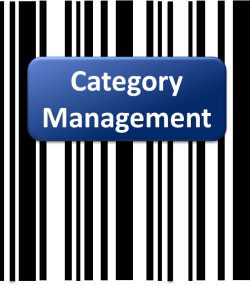Driving Category Management with Sales & Marketing Analytics
 Category Management is a function that helps suppliers develop a category purchase marketing strategy for an individual retail account that best meets the consumer’s needs and, in the process, determines the best approach for influencing that account. Crucial to Category Management is an understanding of the pre-purchase environment for the category and of the vital information behind actual purchases through the use of sales and marketing analytics.
Category Management is a function that helps suppliers develop a category purchase marketing strategy for an individual retail account that best meets the consumer’s needs and, in the process, determines the best approach for influencing that account. Crucial to Category Management is an understanding of the pre-purchase environment for the category and of the vital information behind actual purchases through the use of sales and marketing analytics.
The pre-purchase environment includes typical marketing tools which influence the consumer’s brand choice before they go into the store; for instance: product and packaging design, above the line advertising, direct promotions to the consumer. The in-store tools with which to influence consumers in the purchase process are availability, shelf position/space allocation, communications and in-store promotions. Whether or not the supplier has influenced the in-store activity for the category, each of the various in-store tools will in some way impact on the shopper – not just in terms of behavior but also in terms of their perceptions of the category as a whole and the individual brands within it.
Once the pre-purchase environment has been determined, the next step for the supplier is how to use (for the specific account) the in-store tools that are available. To do this we need to understand what each tool can accomplish for each brand.
Retailer scanner data will provide category sales data down to SKUs. With careful analysis, it may be able to indicate the effect on purchasing (as measured by sales) of different shelf layouts, different pricing strategies or different promotions. With access to key account data, we may even be able to look at the effects for specific retailers.
However, this data cannot tell us which consumers are being affected by the activity and in what way their purchasing is being influenced.
Consumer panel data provides a valuable source of information on consumers’ purchasing behavior, both overall and for specific retail accounts. It can tell us which products and brands are bought together, how often and in which pack sizes and variants. What it still won’t tell us is about the vital information behind the purchase, which is crucial to developing a full understanding of a category. For instance, what were the shoppers’ need states driving the purchase; why was a specific retailer used for the purchase; whether the purchase was planned or impulse; what prompted the impulse purchase; why was a planned purchase not made; whether anything else was considered; etc.
Sales and marketing analytics can address each of these core informational needs.
- Efficient Assortment. The goal of any manufacturer or distributor is to determine an efficient assortment of profitable products. Understanding the product category makeup is key to efficient assortment as is the customers that are buying these products. Sales and marketing analytics answer the questions of what products are selling the least and costing the most, who is buying these products, and whether you can present a substitute or replacement item.
- New Product Introduction. Companies take on a significant risk when introducing new products to the marketplace. Sales and marketing analytics help reduce the level of risk by enabling companies to segment market data, perform “what if” scenarios to forecast new product performance, and then ultimately track and analyze a new product’s profitability and how it impacts category revenue.
- Growth Opportunities. In today’s competitive marketplace, up sell and cross sell strategies can generate significant additional revenue. With sales and marketing analytics, sales and marketing executives and line of business managers can quickly understand what categories and SKUs should be presented to their customers or to new markets.
- Profit & Loss. Category managers are often responsible for understanding the P&L of their categories. In most cases, this is a tedious manual effort that may not provide results quick enough to make effective, timely decisions. Sales and marketing analytics provide the ability to analyze gross profit at not only the category or SKU level, but also by customer and other groups.
- Promotional Activity Evaluation. Companies are constantly looking for ways to increase their sales volumes and inventory turns. Often, they create trade promotions to encourage trading partners to sell more, or they undertake marketing campaigns to increase consumer demand. Sales and marketing analytics not only allows for planning of any of these types of promotional funds, but also allows for analysis of their effectiveness.
- Scorecard. One of the biggest challenges facing Food and CPG manufacturers and distributors is understanding the needs of the other and putting those needs into strategies and objectives that can be measured. Sales and marketing analytics provide the capability to establish guidelines and monitor them in an ongoing fashion. Internally, performance can be measured against established metrics to determine areas of strength and weakness.